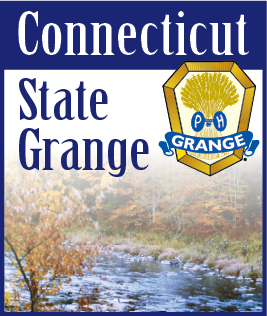| JUNE 25, 2018 --
The following is another excerpt from the publication, “The Connecticut Granges.” This month we look at the town of Lyme and Lyme Grange.
“It is one of the loveliest nooks on the New England cost, and if its distinguished sons and daughters could all be gathered home, the world might well pause to exclaim, in figurative language: ‘However small a treet in the great orchard, Lyme is a matchless producer of fruit.’ ” This is what Martha Lamb, the distinguished historical writer, had to say in a delightful article about old Lyme, in the Harper Magazine for August, 1876. These seem to have been Lyme’s contribution to Connecticut’s title to greatness. It was a generous quota of surpassing quality. Nature had done little for the town to make it a producing factor in the material growth of the commonwealth, but an abundant compensation lay in its rich fecundity as the mother of patriots, statesmen, jurists, divines and men and women skilled to mould events and character for the shaping of human progress. Its historing during the period in which the revolt of the Colonies against British opression was brewing, is fruitful of interest, and makes it the peer of the home of Jonathan Trumbull. Lyme and Lebanon were linked by a fraternity of spirit which would have made them the twin sisters of sedition.
Settlement began in 1664 in that part of the town set off in 1855 and incorporated as Old Lyme. It was called East Saybrook then, and doubtless many of its first comers were from the Saybrook colony on the west side of the Connecticut River, of which it was a part. It was set off and erected into a township in 1667.
The settlers cast off their allegiance to the Saybrook church in 1666 and employed Mr. Noyes to perform the ministerial offices. No ecclesiastical society was formed until 1693, the functions pertaining to such being administered by the town. On March 27, of that year, a society was formed, by unanimous vote of town meeting, and Mr. Noyes, who had been preaching to them for twenty-seven years, was “called to office.” Twenty-seven years would seem a long probation, but this patient cleric may be presumed to have found in his unattached condition many felicities to offset the inevitable annoyance of such abnormal relation. That he was a man of parts, and withal, a pleasing preacher could be fairly assumed from his induction into the pastorate after such an extended period of trial.
In 1817 the fourth church edifice was build and is the present sanctuary of the Society. The elm trees planted about this building by official action of the church are its defense against the rough elements and perennial miracles of praise for those who set them in their abiding places. the Congregational Church at Hamburg was constructed soon after the close of the first quarter of the last century. The date is supposed to have been 1727.
It was through the good offices of Gilbert H. Strong that Lyme Grange No. 147 was created. Inspired by a large faith in Grange principles, and a desire that his town should possess every advantage that would make for its gain and betterment, he applied himself with such earnest purpose and well directed energy that the Grange was organized on the 9th of April, 1896, under the direction of Deputy Samuel A. Chalker.
The roll of charter members includes twenty-two names.
The Grange (as of 1899) has suffered no losses by death, and the losses by demit and withdrawals have been but three. Eleven new members were added in 1896, three in 1897, and ten in 1898, making our total present membership forty-three.
Great pains have been taken by the several Lecturers to provide interesting and instructive programs and the members have largely taken part in the discussion of the general topic. The Lecturer's Hour has been thrown open to the public on several occasions and these meetings have been well attended and those present seemed to enjoy the entertainment provided.
For the first two years after its organization the Grange rented a Hall of Pythagoras lodge in Hamburg at a cost of $30 per annum. In the spring of 1898 a hall nearby was purchased and refitted at a total expense of about $1,000, which amount remains a debt upon the order.
In September, 1897, the Grange held an Agricultural Fair and Cattle Show which was so successful that a much more extenstive exhibition was planned and carried out in the fall of 1898.
There is ample reason for believing the Grange will continue to grow in number and prosperity, and that it will become and ever increasing force for usefulness in the community where it has already wrought for much by its precepts and practices. |
